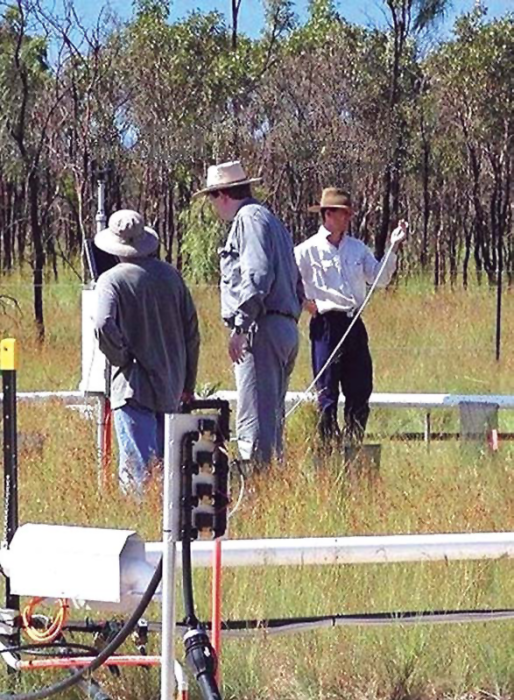


オーストラリアのタウンズビルに、二酸化炭素濃度の上昇と気候変動が熱帯サバンナに影響を与えるための実験施設 (OzFace) が設置されました。世界中には他にも自由大気二酸化炭素濃縮 (FACE) システムがいくつかありますが、OzFace システムはオーストラリア初であり、熱帯サバンナで実施される世界初のシステムです。Campbell Scientific Australia が設計および構築した OzFace システムは、Queensland Nickel Pty主な目的は、自然条件下で、制御された高レベルの CO2 が生態系に与える影響を調査することです。これは単純に聞こえますが、風速と風向が変化する状況で CO2 を正確に測定および制御するには、高度なシステムが必要です。
2000年6月、Campbell Scientific オーストラリア(CSA)は、OzFaceシステムの設計、構築、運用開始の契約を獲得しました。現場でのCO2供給とクイーンズランドニッケル社から提供された3ヘクタールの土地を利用して、2000年10月に建設が開始されました。CSIRO持続可能な生態系のアンドリュー・アッシュ博士とマイクWhiting 博士、および JCUNQ の Joe Holtum 博士は、OzFace の設計段階で CSA に貴重な設計支援を提供しました。Campbell Scientific社、特に Ivan Bogoev 氏は、CO2 供給システムの設計と、実験区画全体での CO2 の変動を測定するための空間サンプリングシステムの設計と製造において、許容重要な役割を果たしました。
OzFace システムには、6 つの同じ実験用リングがあります。これらの八角形のリングは直径が 15 メートルで、各八角形ドアは PVC パイプで構成され、一方の端は確保され、もう一方の端には送風機が取り付けられています。風速に基づいて、独立した 4 つのソレノイド バルブ セットが CO2 の供給速度を制御します。バルブは、風向に置いてCO2の供給を制御します。送風機は、各屋内でCO2と周囲の空気を強制混合、長さに沿ってほとんどの直径10mmの穴から排出します。
各リング内の植生は、さまざまな CO2 レベルにさらされます。 2つのリングは 370 ppm (周囲の CO2 )、2 つのリングは 460 ppm、2 つのリングは 550 ppm です。目標の CO2 濃度を達成するために、それぞれの数値から放出されるCO2の量は、風向と風速に応じて制御されます。このサイトのCO2使用量は、1日あたり約1.5トンです。各実験リング内では、複数の処理によって、様々な放牧効果と肥料効果を検証します。土壌水分、植物バイオマス、植物炭素、土壌炭素はすべて個別に測定され、CO2レベルの上昇による影響が調査されます。
論理的に、OzFace プロジェクトの建設には多くの課題がありました。600メートルを超える溝掘りには、数キロメートルのACケーブル、計装ケーブル、1キロメートルを超えるCO2供給パイプが含まれていました。6つの制御ボックス、48のAC駆動式送風機、80さらにプロセスを複雑にしたのは、建設が典型的なモンスーン雨期の真っ最中に行われたことです。 2001 年 3 月に稼働を開始した OzFace の運用寿命は 5 年と見入っています。
OzFace 計装
6 台の CR10X データロガーが 6 つの実験リングを測定および制御します。データロガーは、MD9 同軸ネットワークを介して、敷地内の空調完備のオフィスにある中央制御コンピュータに接続されます。
pcAnywhereを実行しているコンピュータに接続されたGSM携帯電話により、システム全体のオフサイト制御とリモートデータ収集が可能になります。CR10Xデータロガーは各リングで風速と風向を測定し、放出されたCO2の量を確認します。各リングのSDM -CD16AC制御ポートモジュールは、風の測定値に応じて20個のソレノイドの組み合わせを切り替えます。各データロガープログラムは、放出されたCO2がサンプリング場所に到達するまで適切な警戒を待機し、 Li -Cor GasHound CO2 分析装置で CO2 濃度を測定してから、測定と制御のサイクルを再開します。各データロガー内の高さな PID 測定および制御プログラムにより、システム全体の自動制御が提供されます。
ケーススタディの概要
アプリケーション
二酸化炭素供給・制御システム場所
QNI ニッケル精錬所、オーストラリア、タウンズビル使用製品
CR10X SDM-CD16AC MD9 COAXMD9-L PC208W参加団体
CSIRO, Campbell Scientificオーストラリア、ノース・クイーンズランドのジェームズ・クック大学, Queensland Nickel Pty Ltd計測項目
風速と風向、二酸化炭素圧、二酸化炭素濃度制御対象デバイス
ソレノイドバルブ関連ウェブサイト
The Commonwealth Scientific and Industrial Research Organisation Carbon Dioxide Information Analysis CenterPDFで見る